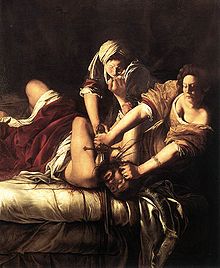Holofernes

According to the Old Testament, Holofernes [ hoˈlo.fɛɐ̯.nəs ] is an Assyrian general who is killed by Judith . It appears in the Book of Judith as a general of the Babylonian king Nebuchadnezzar II. , Who has moved with his army, the states between agents - and the Red Sea to submit as revenge that none of the peoples between the Mediterranean and the Persian highlands Nebuchadnezzar in the war against supported the Median king Arphaxad.
The book tells that Holofernes attacked and besieged the city of Betulia, located on a pass in the Judean mountains, after robberies, murders and pillage throughout the Middle East . With a lack of water, residents are on the verge of surrendering. Some of the residents asked to wait five days before God could save them. Judit (also: Judith), a pious Jewish widow of considerable charm - and equally considerable wealth - decides to save her city. She goes with her maid and wine jugs to the camp of Holofernes' troops, where, because of her beauty, she easily manages to reach the tent of Holofernes. Beguiled by her beauty and wisdom, Holofernes invites her to a feast, during which the servants withdraw discreetly from the tent so as not to disturb the expected night of love. However, she makes him drunk with the heavy wine, and together with her maid she beheads him. Judit returns to Betulia with the severed head. When the soldiers discover the assassinated general in the morning, they panic to flee and the Jews are able to defeat the remaining attackers.
Since the book of Judith is generally viewed as a fictional story, Holofernes is likely not a historical figure.
“See, this is the head of Holofernes, Field Marshal of the Assyrians, and see, this is the blanket under which he lay when he was drunk. Yahweh our God killed him by the hand of a woman. "
The story is therefore about superior power and threat on the one hand and powerlessness and defenselessness on the other. Male strength is weakened by desire. Judit can use her feminine charms to achieve her goal - the averting of great hardship from her people. In artistic representations, therefore, the danger of the sensuality of the feminine is often alluded to.
reception


The story was a popular motif, especially in the Renaissance and Baroque periods, and was created by Botticelli , Lucas Cranach the Elder , among others. , Caravaggio and Artemisia Gentileschi . In the Sistine Chapel in Rome, a representation of the story is also part of the ceiling painting created by Michelangelo Buonarroti (in one of the large corner gussets). The Art Nouveau painter Gustav Klimt created the painting Judith and Holofernes (Judith I) in 1901 , the subject of which he took up again in 1909 with Judith II .
Musically, the death of Holofernes is thematized in the oratorio Juditha triumphans devicta Holofernis barbarie by Antonio Vivaldi . 1923 composed Emil von Reznicek opera in two acts Holofernes , whose libretto he based on the year 1839/40 by Friedrich Hebbel wrote tragedy Judith wrote.
In the election campaign for the 2018 state parliament in Bavaria, the candidate of the party DIE PARTTEI, Andrea Kübert, used a poster motif with herself as Judith and a decapitated Prime Minister Markus Söder as Holofernes.
Web links
- Andreas Angerstorfer : Holofernes. In: Michaela Bauks, Klaus Koenen, Stefan Alkier (eds.): The scientific biblical lexicon on the Internet (WiBiLex), Stuttgart 2006 ff., Accessed on February 25, 2009.